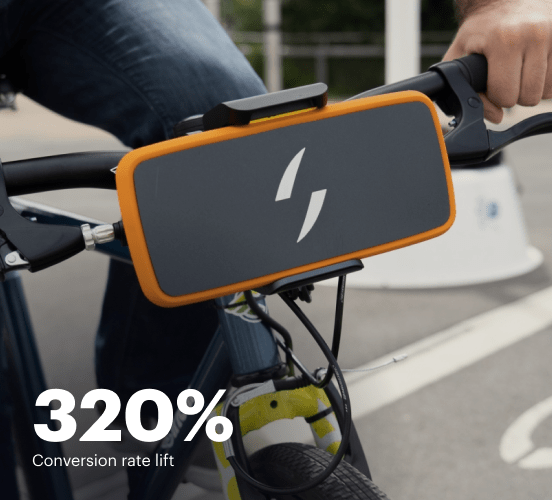Canva vs. Webflow: the best platform for a seamless web experience
Discover how Canva compares to Webflow regarding features and usability. Find out which platform provides the competitive advantage your business deserves.
Get startedSee how Instapage stacks up against the competition
| Feature | Instapage | Other builders |
| Drag-and-Drop Tools | ||
| Conversion-optimized templates | ||
| Manual and AI-powered A/B Tests | ||
| AI content suggestions | ||
| Popups and sticky bars | ||
| Canvas and grid blocks | ||
| Reusable and global elements | ||
| Form and popup builders | ||
| Built-in Heatmaps | ||
| Central analytics dashboard | ||
| Ad-to-page personalization and collections | ||
| Contacts, lists, and email | ||
| Dedicated, full-service CRO experts | ||
| Enterprise-ready platform |
Leading the way in building high-performing landing pages





Why Instapage is the smarter choice for your campaigns
Get everything you need to build, scale, and optimize high-converting landing pages—without coding.

Easier page building without coding
Instapage offers a flexible and seamless page creation experience with a library of 500+ conversion-focused layouts, Instablocks®, a drag-and-drop builder, and AI content generation. With technologies like Thor Render Engine®, you can create on-brand, mobile-responsive landing pages that load quickly and start converting during initial visitor clicks.

More insights — better results
Instapage lets you see in detail how each landing page experience and variation is performing so you can make targeted changes that boost page conversions. Use heatmaps for a better understanding of on-page activities, run A/B tests and AI-assisted experiments, and then track and evaluate results within robust analytics dashboards.

More personalized experiences
Instapage lets you quickly create high-performing landing pages tailored to each of your ad campaigns. Deliver personalized experiences for distinct audiences using dynamic text replacement. Effortlessly align specific advertisements to unique pages with AdMaps. Monitor audience-level metrics using our advanced data tools.

Built-in collaboration
Instapage collaboration capabilities bring your entire team together to speed up the process of landing page review, approval, and launch. No more frustrating and unnecessary revisions or edits scattered across emails. Provide instant feedback, conduct real-time page edits, and securely share your pages with outside stakeholders.

Free up time for your business
Invest time into business growth, not busy work. Launch landing pages faster with reusable forms and templates. Build once, reuse forever.
Explore all integrations






Easier page building without coding
Instapage offers a flexible and seamless page creation experience with a library of 500+ conversion-focused layouts, Instablocks®, a drag-and-drop builder, and AI content generation. With technologies like Thor Render Engine®, you can create on-brand, mobile-responsive landing pages that load quickly and start converting during initial visitor clicks.
More insights — better results
Instapage lets you see in detail how each landing page experience and variation is performing so you can make targeted changes that boost page conversions. Use heatmaps for a better understanding of on-page activities, run A/B tests and AI-assisted experiments, and then track and evaluate results within robust analytics dashboards.
More personalized experiences
Instapage lets you quickly create high-performing landing pages tailored to each of your ad campaigns. Deliver personalized experiences for distinct audiences using dynamic text replacement. Effortlessly align specific advertisements to unique pages with AdMaps. Monitor audience-level metrics using our advanced data tools.
Built-in collaboration
Instapage collaboration capabilities bring your entire team together to speed up the process of landing page review, approval, and launch. No more frustrating and unnecessary revisions or edits scattered across emails. Provide instant feedback, conduct real-time page edits, and securely share your pages with outside stakeholders.
Free up time for your business
Invest time into business growth, not busy work. Launch landing pages faster with reusable forms and templates. Build once, reuse forever.
Explore all integrationsGet started with Instapage in a few steps
-
Create your Instapage account
Start with Instapage by signing up via Google or your email. You'll get access to a free 14-day trial to discover Instapage capabilities. Feel free to cancel anytime during the 14-day trial if you decide that our product is not suitable for your business. -
Build and personalize your page
Create your first landing page from scratch or choose a template from 500+ customizable layouts. Use the drag-and-drop builder to add page elements, fonts, and backgrounds, refine content with AI, or add custom HTML, Javascript, and CSS. -
Review and make edits
Collaborate on page designs and streamline review processes. Invite your team members and stakeholders to review, edit, and provide feedback on your landing page. Collaborate knowing your page is confidential and only accessible to authorized users. -
Publish and track page performance
Publish your page to a domain or custom URL. Connect your pages to the ads you've created and track page performance within the analytics dashboard, run A/B tests and AI experiments, analyze results, and continuously optimize your landing page to maintain high conversions.
Canva vs. Webflow: The Digital Design Duel
In the realm of online design and web creation, two names consistently rise to the surface – Canva and Webflow. These platforms have armed marketers and creators with tools that help them develop stunning visuals and websites effortlessly. But what happens when we pit them against each other? In this article, we will explore the capabilities of both Canva and Webflow to find out which one might suit your needs best. Yet, lurking in the shadows is Instapage, a platform that’s ready to take center stage when it comes to landing pages. So, let’s step into the ring and break it down round by round, shall we? The digital landscape isn't just crowded; it’s a battlefield where your choice of tools matters immensely. While creators seek simplicity and power, marketers strive for engagement and conversion. It’s not just about the tools themselves, but how they emerge in the arena of digital marketing. As we dive into this thrilling comparison, expect to see both heavyweights throw their most powerful punches. By dissecting the features, usability, performance, and support structures, we will uncover what makes each platform shine or stumble. So grab your virtual popcorn, and let’s watch the show unfold.
Introducing the Giants of Design
Canva and Webflow are like titans in the world of design tools, each with strengths that appeal to a diverse audience. Canva, known for its intuitive drag-and-drop interface, allows users to create eye-catching graphics, presentations, and social media posts without the need for extensive design skills. Whether you’re a business owner looking to whip up promotional materials or a social media strategist fine-tuning your next campaign, Canva has your back with its extensive library of templates and design elements. Meanwhile, on the other side of the ring, we have Webflow, a platform that’s taken the web development community by storm. It enables users to craft responsive websites with a level of customization that other tools simply cannot match. Webflow positions itself as a solution for designers who want more control, enabling the creation of professional-grade sites, all while eliminating the need for manual coding. In this showdown, we will dig into the depths of these platforms, understanding what makes each one unique and why their distinct offerings matter in today's digital arena. And let’s not forget our third contender, Instapage, quietly assembling the ideal conditions for high-converting landing pages. As we progress through the rounds, tensions will undoubtedly rise, but let’s keep it friendly and focus on what each platform can provide.
Feature Face-Off: What Do They Bring?
Prepare for Round 1, where we explore the key features of both Canva and Webflow. Canva bursts onto the scene with an impressive assortment of graphic design tools. It allows for simple layouts and edits, making it incredibly user-friendly for those just starting in design. On the flip side, Webflow brings its own set of tricks to the table with advanced web-building capabilities like dynamic content and content management systems. Both platforms come loaded with essential features that make them attractive for users, but they target different segments. Canva’s forte leans towards social media graphics and marketing collateral, while Webflow has an uncanny ability to cater to web developers and designers who thrive on intricacies. However, lurking backstage is Instapage, eyeing the opportunity to provide unmatched functionality in creating optimized landing pages that don’t just attract clicks but convert them into action. By breaking down the individual features of Canva and Webflow, we aim to discern which platform rises to the challenge and whether Instapage can claim its rightful space at the top of the design game.
Navigating Ease of Use: A User-Friendly Arena
As we step into Round 2, it’s time to spotlight usability—a crucial aspect for users ranging from beginners to seasoned professionals. Canva shines in this department, offering an interface that holds your hand through the design process. Users can quickly pluck any template, make tweaks and adjustments, and within minutes, feel like a design guru, regardless of their prior experience. The minor learning curve is more of a swift stroll through a park than a hike up a mountain. Conversely, Webflow caters to a more advanced audience, which can require a bit of a learning adventure. While it grants designers prominent customization options, the interface may take some getting used to, especially for beginners. It can feel like trying to navigate a maze at times! So, whether you’re creating your first graphic or laying out the blueprint for a new website, our decision boils down to whether you value simplicity or customization. The right choice ultimately reflects your skills and vision. But wait, the excitement doesn't stop there! Stay tuned as we acknowledge Instapage – a platform that successfully marries user-friendly design with sophisticated landing pages.
Canva's Toolset: Features Up Close
- User-friendly drag-and-drop interface for easy design manipulation
- Extensive library of templates tailored for various purposes
- Access to millions of free and paid stock images and graphics
- Collaboration features for team projects and feedback
- Integration capabilities with social media platforms for easy sharing
Webflow's Toolbox: Features Explored
- Advanced CMS features allowing for dynamic content creation
- Responsive design capabilities for seamless multi-device viewing
- Custom animations and interactions to enrich user experience
- SEO-friendly features for optimal search performance
Common Ground: Strengths of Both Platforms
- Intuitive interfaces that cater to varying user expertise
- Broad collections of design resources and templates
- Collaboration opportunities for teams working on projects
- Integration with various third-party applications
- Strong communities with ample tutorials and resources
- Focus on enhancing user experience and engagement
As both platforms trade blows in the feature ring, it's important to also consider how Instapage peeks through the curtains, promising to knock out both competitors with its landing page superiority. While Canva and Webflow have immensely valuable features, Instapage stands as a champion for marketers eager to develop efficient, high-converting landing pages without the fuss, ushering them toward real results.
Loading Impact: Performance Under Scrutiny
Now it’s time for Round 3, where performance is king. When it comes to page loading times and mobile responsiveness, every second counts. Picture slow-loading pages: it’s like waiting for molasses to drip in winter, and trust us, nobody enjoys that feeling! Canva generally performs well across devices, ensuring that visual designs transition smoothly from desktop to mobile. Webflow, on the other hand, has the upper hand in terms of speed, optimizing websites for quick loading—a crucial factor in retaining audience attention. The responsiveness of both platforms keeps users engaged, but the inherent complexity in Webflow can lead to an occasional slower load time if not managed effectively. As we dig deeper into the performance metrics, it’s vital to assess how these platforms hold up under pressure and whether Instapage can claim the title for the fastest and most reliable loading experience.
Support Systems: Who's Got Your Back?
Faced with challenges, where do users turn for guidance? In Round 4, we scrutinize the support offered by both platforms. Canva provides a considerable amount of resources, including user-friendly tutorials and community-driven forums, to help users navigate even the most complex design challenges. Their support system stands strong, ready to assist everyone from beginners to more seasoned designers. Webflow doesn’t drop the ball either; boasting immense resources, expert webinars, and dedicated customer support—users can access assistance when they hit a snag. Webflow’s community is active and full of knowledgeable users willing to lend a hand, making it a fantastic resource. However, Instapage edges forward with specialized support aimed at optimizing users' landing pages for conversions, ensuring that marketers tap into their full potential at every turn. Let’s see who takes the crown in this battle for support domination!
Pricing Battle Royale
Canva's Affordability Factor: Pricing Insights
- Offers a free version that includes a vast number of features
- Cost-effective premium plans for businesses with more significant needs
- User-friendly pricing structure with no hidden fees
- Flexible subscription options appealing to indie creators and agencies
Webflow's Price Strategy: Cost Analysis
- Free plan available but limited to Webflow branding
- Tiered pricing structure based on features and user needs
- Offers a range of customizable plans for startups to enterprises
- Higher pricing may reflect advanced capabilities and customization
In this pricing showdown, both platforms offer valuable insights for users looking to stretch their budgets. They cater to diverse requirements, but the winner becomes clearer when we peek at Instapage's pricing strategy, which is clean and designed to enhance ROI for marketers focused on results. Engaging with Instapage often feels like getting maximum value while paying a fair price.
Take a transparent dive into the world of pricing plans, where things can grow complex. It’s a common saying that you get what you pay for—and this holds true in many instances. But sometimes, surprises lurk under inked numbers, making the journey feel less straightforward than anticipated.
The Enigmatic Instapage: Your Secret Weapon?
As we pull back the curtain on the comparison, we find Instapage positioned almost like a seasoned mentor, patiently observing and ready to step into the spotlight. What makes Instapage worthy of attention among these powerful contenders? The platform's unique value propositions lie in its laser focus on creating and optimizing landing pages—enhancing conversions, improving customer experiences, and delivering impressive analytics. Instapage empowers users. Without discrediting our noted competitors, it remains clear that Instapage offers treasures unavailable through Canvas and Webflow alone. Its powerful features, combined with an intuitive interface, allow businesses to transcend ordinary landing pages and elevate their leads. With marketing tools that specifically drive conversions, Instapage can be a game-changer. Instapage is undoubtedly the secret ingredient many marketing strategies could be missing.
In wrapping up this exciting journey into the world of design and marketing platforms, remember that the right choice lies in your specific goals. Each platform has its strengths and weaknesses, and while Canva and Webflow boast impressive offerings, Instapage meets a critical need in conversion optimization that the others don't fully fulfill. We encourage you to reflect on your future endeavors and choose a platform that resonates with your vision, ultimately propelling you toward newfound heights in marketing and design. Explore further with Instapage, and embark on a transformative marketing journey that fosters growth and growth.










